
- Vintage Sterling Silver
- Base Metal
- Department
- Metal
- .925 Sterling Silver (3)
- 925 Silver (3)
- 925 Sterling Silver (5)
- Brass (7)
- Fine Silver (10)
- Rose Gold (2)
- Rose Gold Plated (5)
- Silver (330)
- Silver Plated (10)
- Sterling Silver (2878)
- Sterling Silver .925 (2)
- Sterling Silver 925 (5)
- Sterling-silver (3)
- White Gold (2)
- White Gold Plated (30)
- Yellow Gold (7)
- Yellow Gold Plated (26)
- Other (751)
- Shape
- Style
- Vintage
Antique Vintage Nouveau Sterling 800 Silver Egyptian Filigree Pendant Necklace
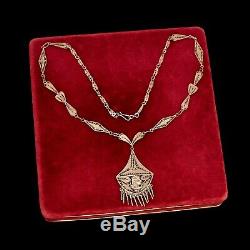
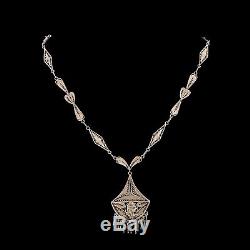
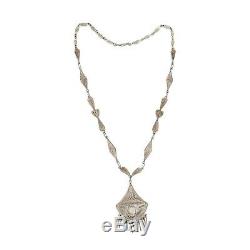
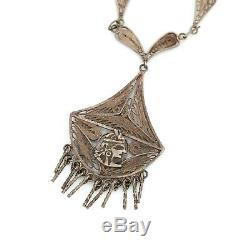
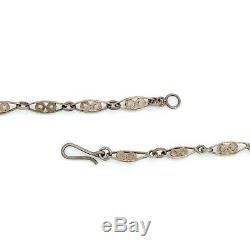
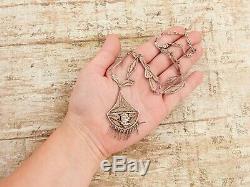


We have similar Egyptian and Filigree items, which would pair nicely with this piece, for sale this week. Listing Description by: Cait P.
Age Circa: Art Nouveau C. Item Measurements: The necklace has a wearable length of 19 and the chain measures 7.95 mm wide.
The pendant measures 2.1" in length and 1.3" wide. Link Type: Fancy Geometric Filigree Links. Handmade during the Art Nouveau era in the Egyptian Revival style. The necklace and pendant are made out of. 800 sterling silver, a popular purity of silver amongst jewelers during this time period, particularly in filigree pieces.Filigree geometric links comprise the chain. A large filigree pendant is strung on the chain and features the bust of a person in profile stylized to look like the figures seen in ancient Egyptian art. Completing the necklace is a hook clasp.
When worn, the necklace sits below the collarbone with the pendant resting against the decolletage on most people. This listing is for the item only.
This was very true due to the gorgeous designs that came out of this period. This era focused on women and the beauty of nature and the pieces were often large. Enamel was a common material used in Art Nouveau jewelry as the period was more about the importance of the design over the materials used to create it. The Art Nouveau period happened before the start of the first World War, when mass manufacturing took over the production.
Of many products, including some jewelry. Archaeological revival jewelry was inspired by the excavations and discoveries of Roman, Byzantine, Egyptian, and Etruscan sites in the 18th and 19th Centuries. These archaeological digs uncovered beautiful works of decorative arts, giving jewelers a glimpse into the past for inspiration for contemporary designs. Some of the revival styles incorporate the use of filigree and granulation decorations.The revival styles emphasized the contrast between antiquity and modernity, with jewelers of the modern world borrowing motifs and techniques from the ancients, to perfect with advanced technologies and incorporate into modern designs. There were two primary waves of popularity for Egyptian motifs and imagery. The first Egyptian Revival took place during the 1700s, inspired by Napoleons campaign in Northern Africa as he swept across the land he collected and sent back beautiful pieces of antique Egyptian jewelry.
The influx of designs and styles caused a fad, and Egyptian inspired jewelry, clothes, and decorations took off. The second Egyptian revival was influenced by archaeological discoveries and advancements, specifically the rediscovery of King Tutankhamen's tomb in 1922.
Egyptian revival common motifs include the Eye of Horus, which is meant to symbolize for healing and protection, scarabs and lotus flowers which express creation and life, and the Ankh symbol which indicates eternal life. 800 silver, also called Coin Silver, is made from silver coins used in European countries pre-1940. During this time period, it was easier for jewelers and silversmiths to use coins that were already guaranteed at a certain purity, than using another form of silver and having to guess at the purity level. Filigree metalworking is a delicate form of art and has been found as early as 3,000 BC in Mesopotamia. It was perfected by the Phoenicians and Etruscan civilizations between the 6th and 3rd centuries BC. It involves stamping out a design in metal and hand bending and twirling threads, combined with tiny beads, until a final motif emerges. It is reminiscent of lace and considered one of the most difficult metalworking processes. Filigree is still a very popular technique in India and Asia. The item "Antique Vintage Nouveau Sterling 800 Silver Egyptian Filigree Pendant Necklace" is in sale since Sunday, November 24, 2019. This item is in the category "Jewelry & Watches\Vintage & Antique Jewelry\Fine\Art Nouveau/Art Deco 1895-1935\Necklaces & Pendants". The seller is "abeautifultimeco" and is located in Fort Collins, Colorado. This item can be shipped worldwide.- Modified Item: No
- Country/Region of Manufacture: Unknown
- Style: Chain
- Metal Purity: .
800
- Metal: Sterling Silver

